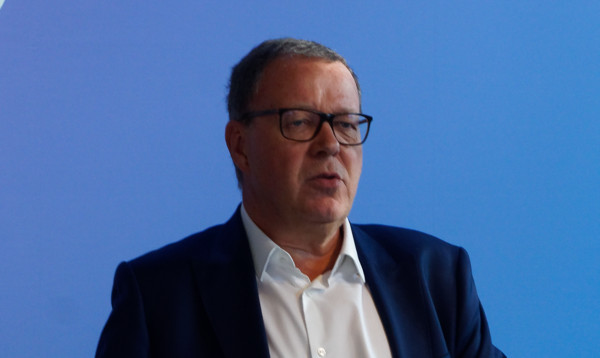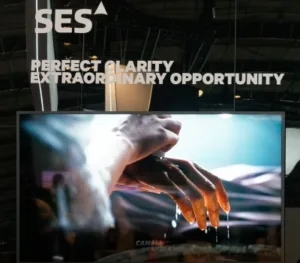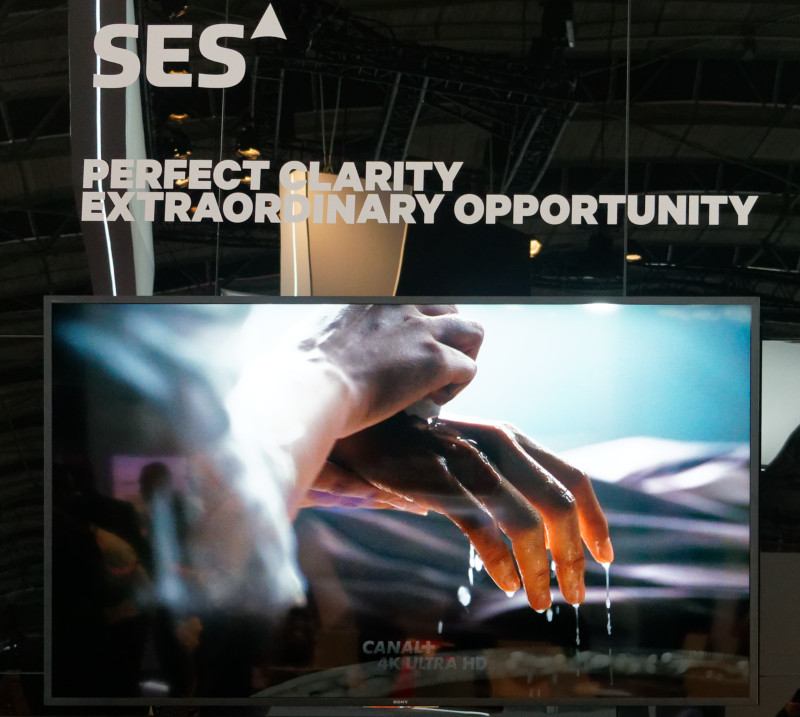SES has traditionally held a press event and dinner on the evening before IBC but this year had a more informal event at breakfast. We went along.
Steve Collar has been the CEO and President of SES since February and he came from SES Networks to take over the position earlier this year.
 Steve Collar became CEO earlier in 2018. Image:Meko
Steve Collar became CEO earlier in 2018. Image:Meko
He started by saying that there is a lot happening in space – SpaceX has announced that it has its first passenger to go around the moon (a Japanese artist). The small satellite business is really growing fast – there is lots of investments in new constellations and a focus on communication. Two thirds of the satellite business is in video and is forecast to remain video intensive.
SES Networks is one third of the overall SES business and the two divisions are going slightly different ways. The Networks business is ‘vibrant’, along with the space business. There is real disruption coming from the segment. SES has completed four successful launches already this year and has seen double digit growth in the last two quarters. By 2022, 50% of the SES business is expected to be in Networks which means a good balance, in Collar’s view.
New facilities being enabled by SES include aviation networking. Three years ago, you took your own content onto aircraft, or the airline provided it. Now you probably don’t have a screen on the seat back in North America as travellers are expected to have their own devices and connections are becoming ubiquitous. Of course, for some travellers, this is not seen as an advantage! However, most travellers prefer to stay connected and Collar said that connectivity is the top factor in choosing carriers in the US and the SES aim is to develop the same experience in the air as on the ground.
Half the planes that have connectivity already use SES and there will be an increase, he believes.
SES Is Cruising
Cruising is another big growth market for SES. Five years ago, 2 Megabits would have been shared by 5000 people. Now there is 500 Mbits, typically. Sharing the experience is a huge part of being on holiday and recommendations are very important for cruise companies. Social media is a big influencer on cruise purchase. It’s not just the better experience on the cruise and potential income from connection charges, it’s also very important for social media to add to the marketing activities of the cruise operators. Cruise ships can’t be built fast enough at the moment and the change to growth happened when connectivity changed.
In many markets, if you boost connectivity, you build economic activity. Success comes from being part of the connected world.
O3b is currently the only technology to supply broadband via satellite outside the geostationary category. SES’s MPower satellites (which are not in stationary orbit, but orbit at very high speed and low altitued) offer very low latency and high bandwidth. 5G and the IoT will be big users of this kind of technology because of the amount of data that is produced in an airliner. This can include keeping control of or tracking aircraft (for example, the ‘black box’ could be permanently connected). Another application could be sending info on wear or faults in aircraft parts that can send information ahead to allow, for example, the advance supply of parts for rapid maintenance. That kind of application could be very powerful.
SES has made a partnership with IBM to allow the use of SES satellites to connect to IBM’s cloud which extends IBM’s connectivity globally, even where there is no other infrastructure.
SES Video Update
Ferdnand Kaiser runs the video business and he talked about the disruption to traditional TV from Amazon and Netflix. These days, there is compelling content that can be consumed everywhere and at attractive prices. OTT is increasingly used as a complement to traditional broadcast. UK TV viewing is around 291 minutes per day – ten years ago it was 230 and in Germany it is now 254 minutes and was 208 ten years ago. Broadcasters have to offer OTT but don’t have CDNs so suffer during major events – especially sports events where everybody wants to watch at the same time.
 Kaiser Runs the video side of the business – currently 2/3rds. Image:Meko
Kaiser Runs the video side of the business – currently 2/3rds. Image:Meko
SES sees an opportunity for 262 million new TV homes with 170m in Asia in the next five years. There is a lot of work still to do to achieve Analogue Switch Off (ASO) in emerging markets with 300 million homes still to be converted, lots of them in Africa and Latam. Larger screens with higher quality and the best quality are important for the viewing experience.
In Europe, the US and Latin America the markets are mostly UltraHD sets and the number of UHD channels is growing consistently. Linear TV continues to be the main revenue stream for SES. The firm has ‘technical reach’ (via cable and DTT head ends as well as Direct to Home – DTH) into 351 million households. SES broadcasts more than 7900 channels and that number is growing. 2700 are now in HD. There are 50 UHD channels (44% of all global UHD channels) and high resolution continues to grow in importance. The EU is the biggest market, especially the UK and Germany. US is important for cable distribution (where satellite is used to send content to local head end hubs for local distribution by cable).
The company has four strategic initiatives:
- The company is planning four new satellites and more receivers to support cable and also for DTH.
- Value added services development via the MX1 division. VOD everywhere is important for distribution by fibre and internet. This allows combination of linear and non-linear content.
- Platforms continue to evolve and SES wants to be part of building ecosystems. The company is supporting 10 UHD channels into cable and can offer everything from content aggregation to distribution to cable head ends.
- The company is developing satellite & terrestrial networks in West Africa it is establishing free TV platforms and a DTT backend. Pay TV will also eventually come to this
SES is confident about its position in the market for distribution and services.
Interview about Video
After the formal part of the event, we got to talk to Kaiser, who told us that O3b would really come into its own alongside 5G as it can offer internet connectivity anywhere and IoT apps will not be confined to locations where there is an ethernet port.
In 8K, Kaiser said that there is no real pressure to start to support, but of course, SES will. One application that he expects to see enabled by 8K is the delivery of content for large public displays and LED walls for public viewing and something might be possible by 2020, in support of the Olympics.
The contribution side will also be developed to support the 8K format. As usual with new video technology, SES expects Pay TV to start offering it, followed by free TV and finally by public service broadcasters. For example, France will probably see the first public service UltraHD. By 2022, SES expects much or all of the content in some countries to be in HEVC.
Booth Tour
SES didn’t have any particularly new or interesting demos on the booth, but it did have some Tech Talks, including one on an Arte test broadcasting programme. See our report here.


